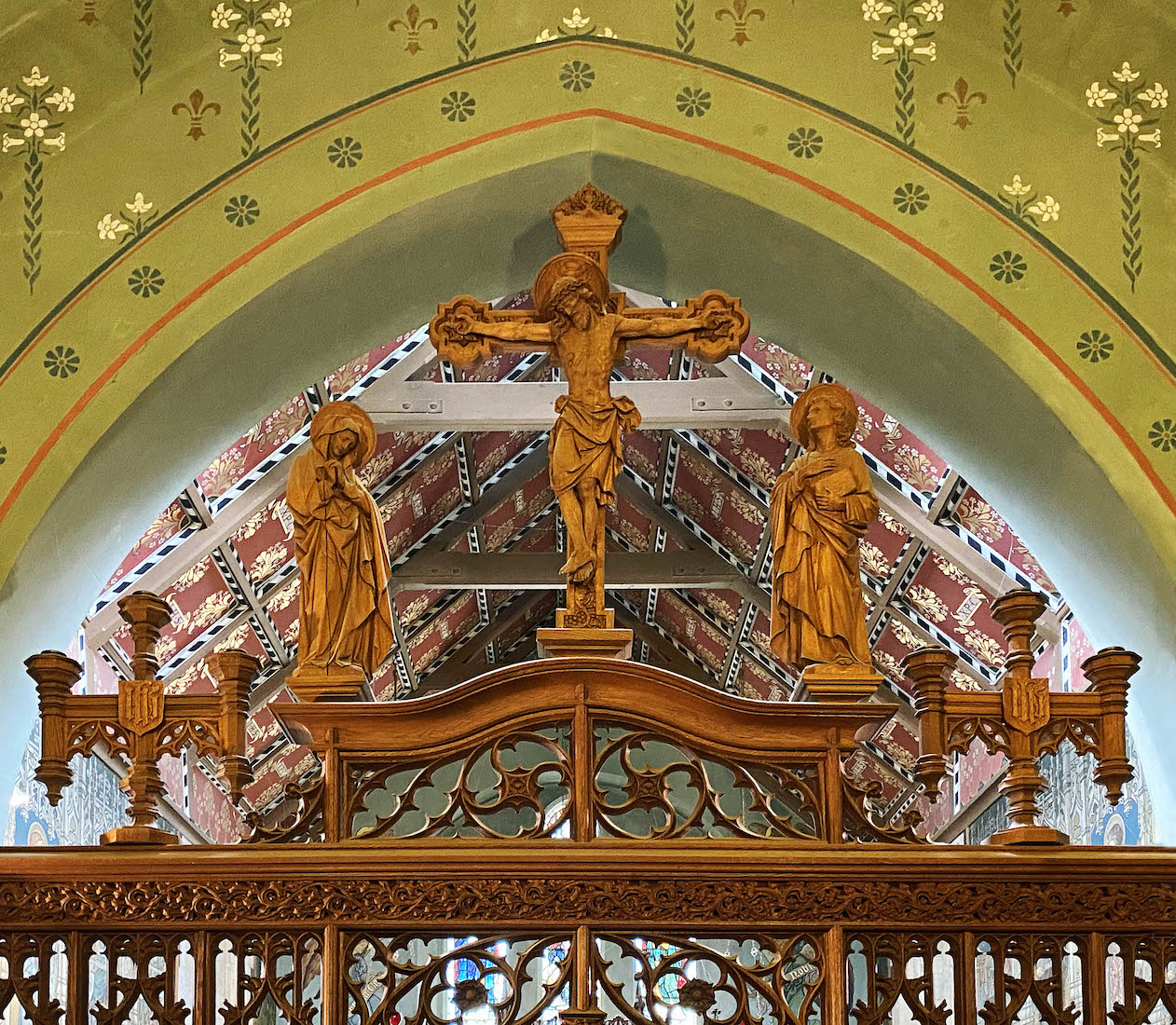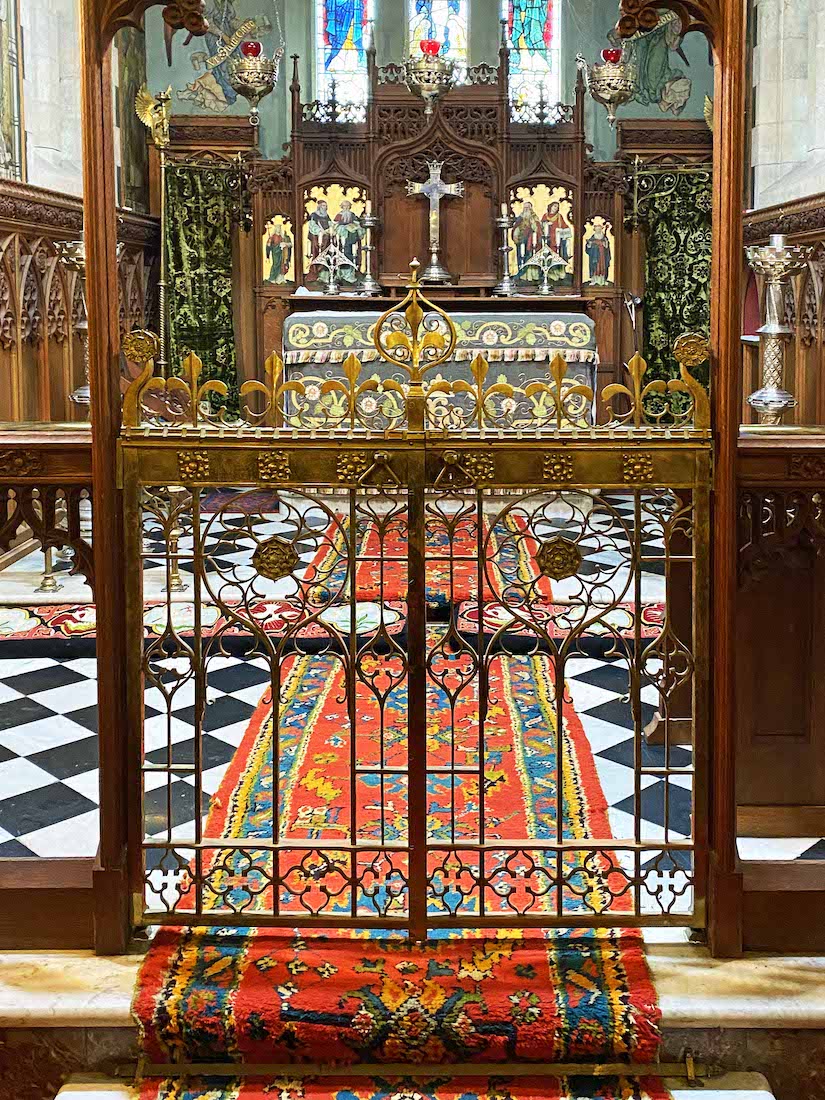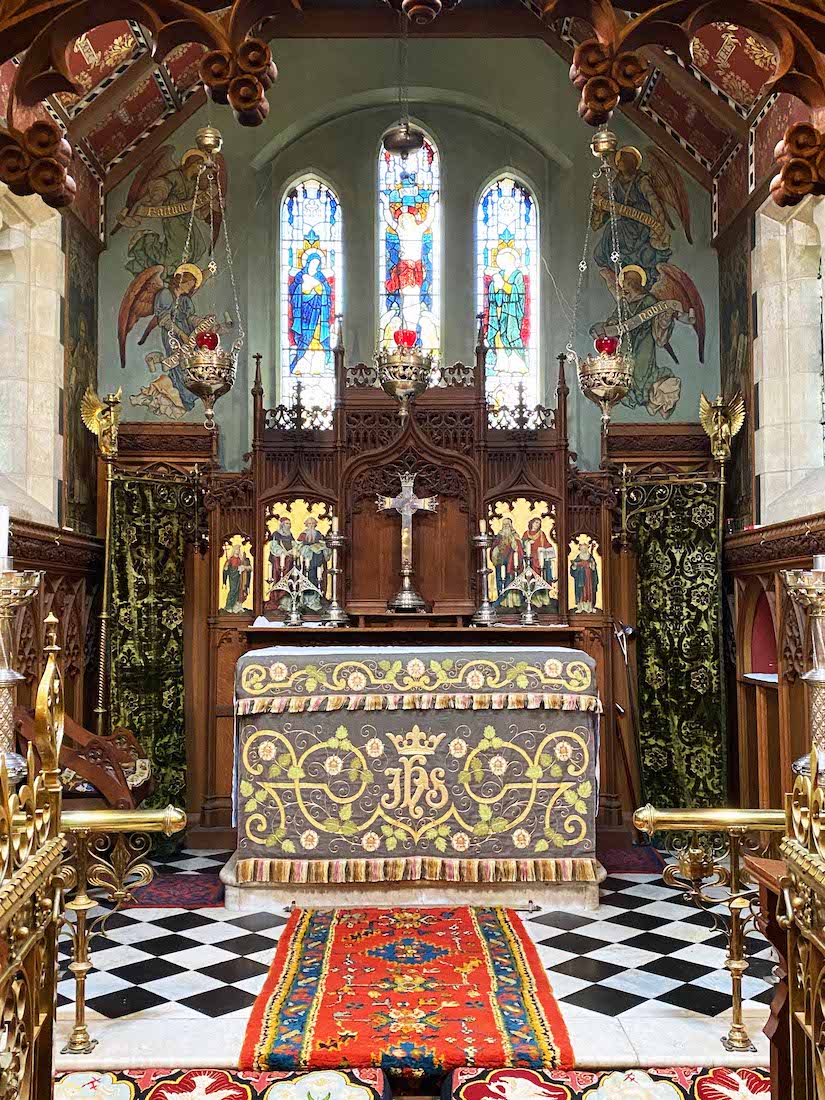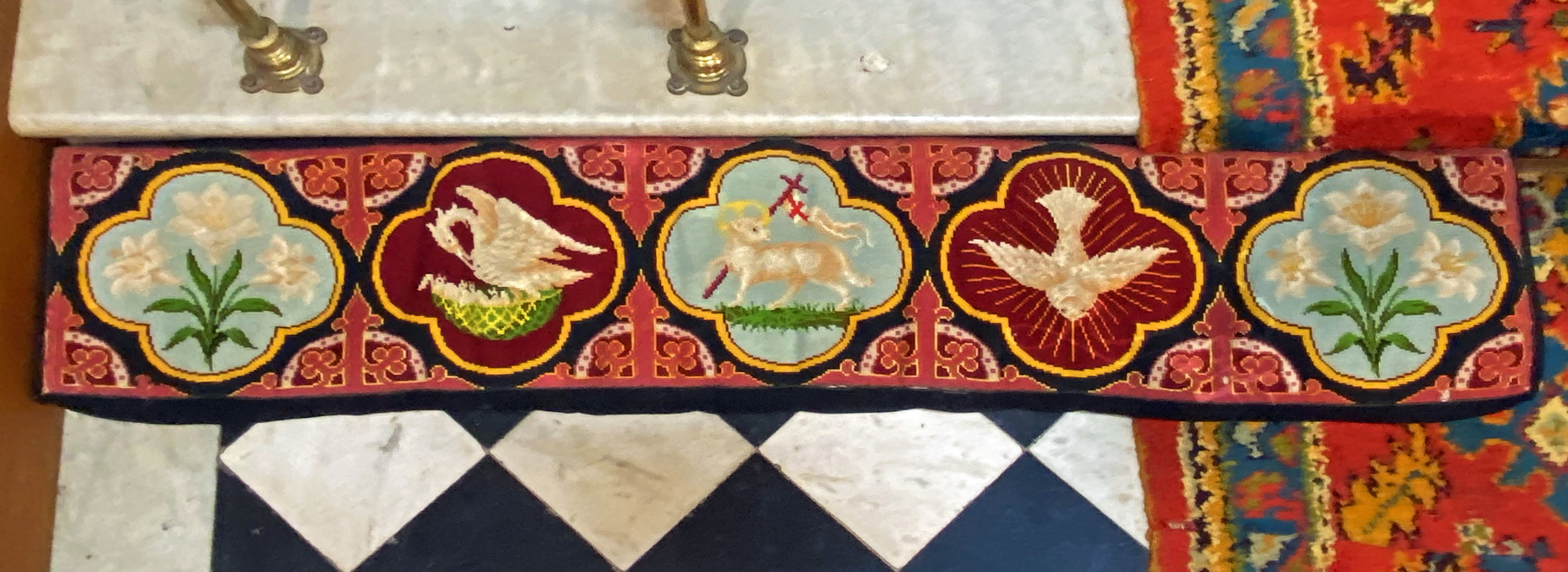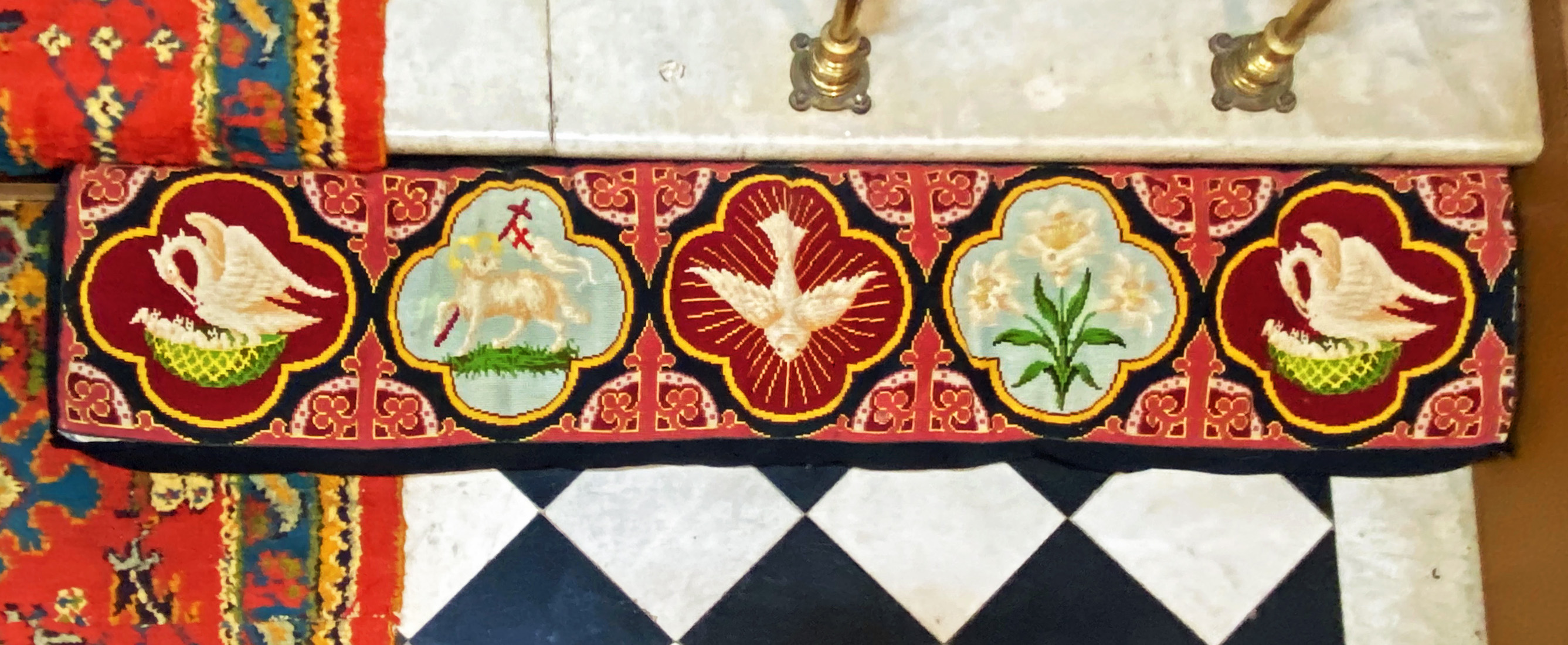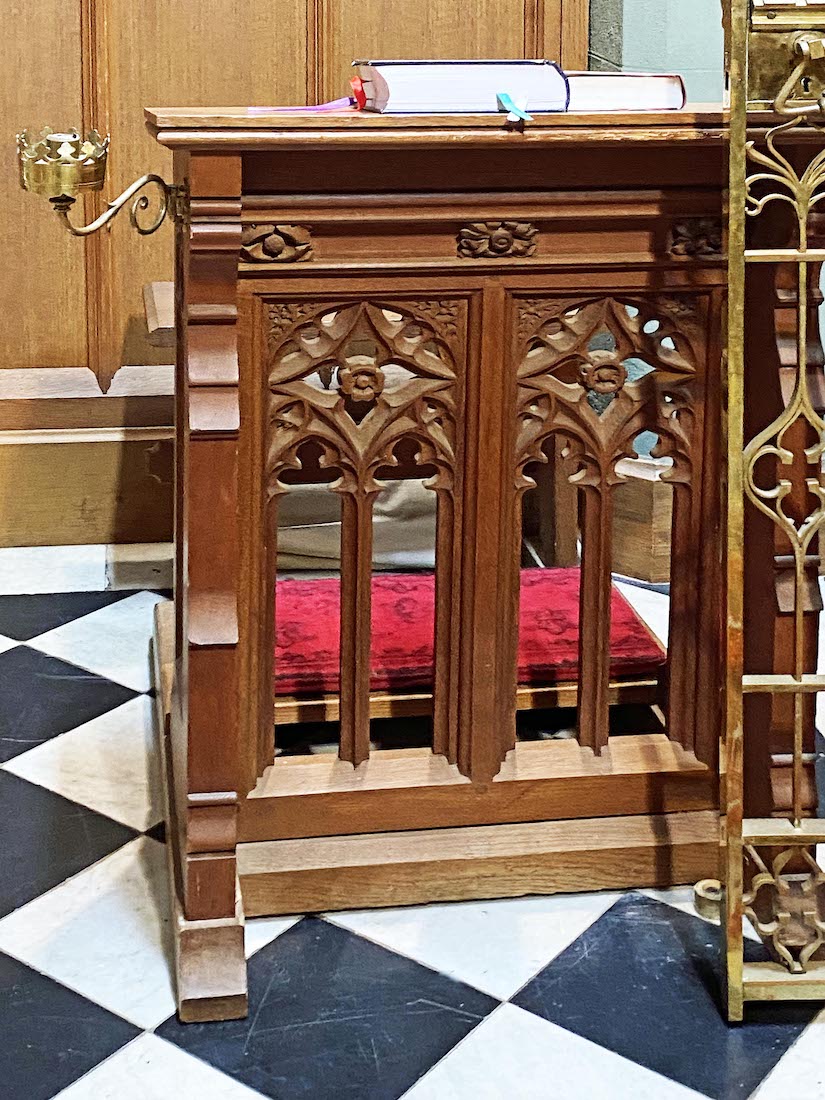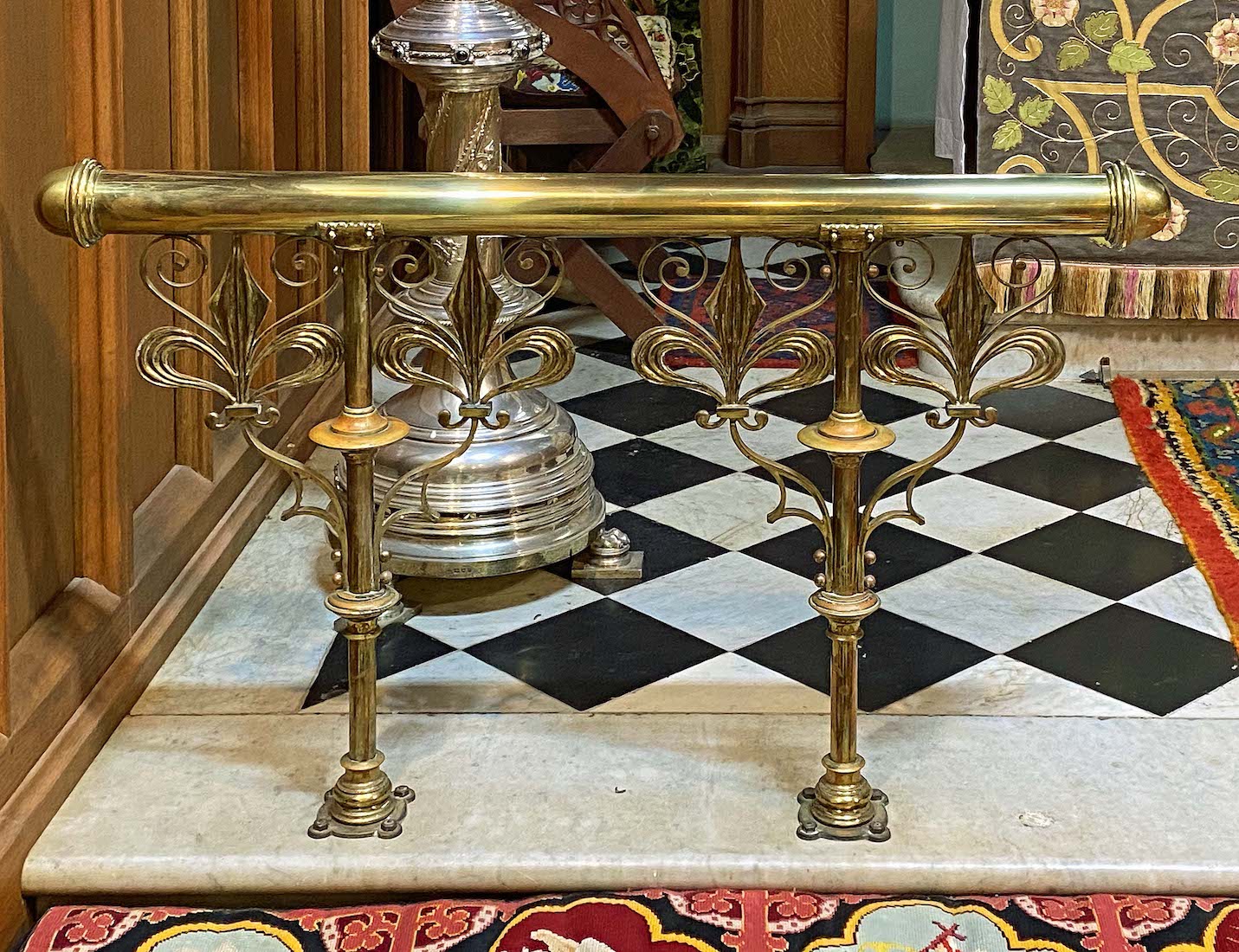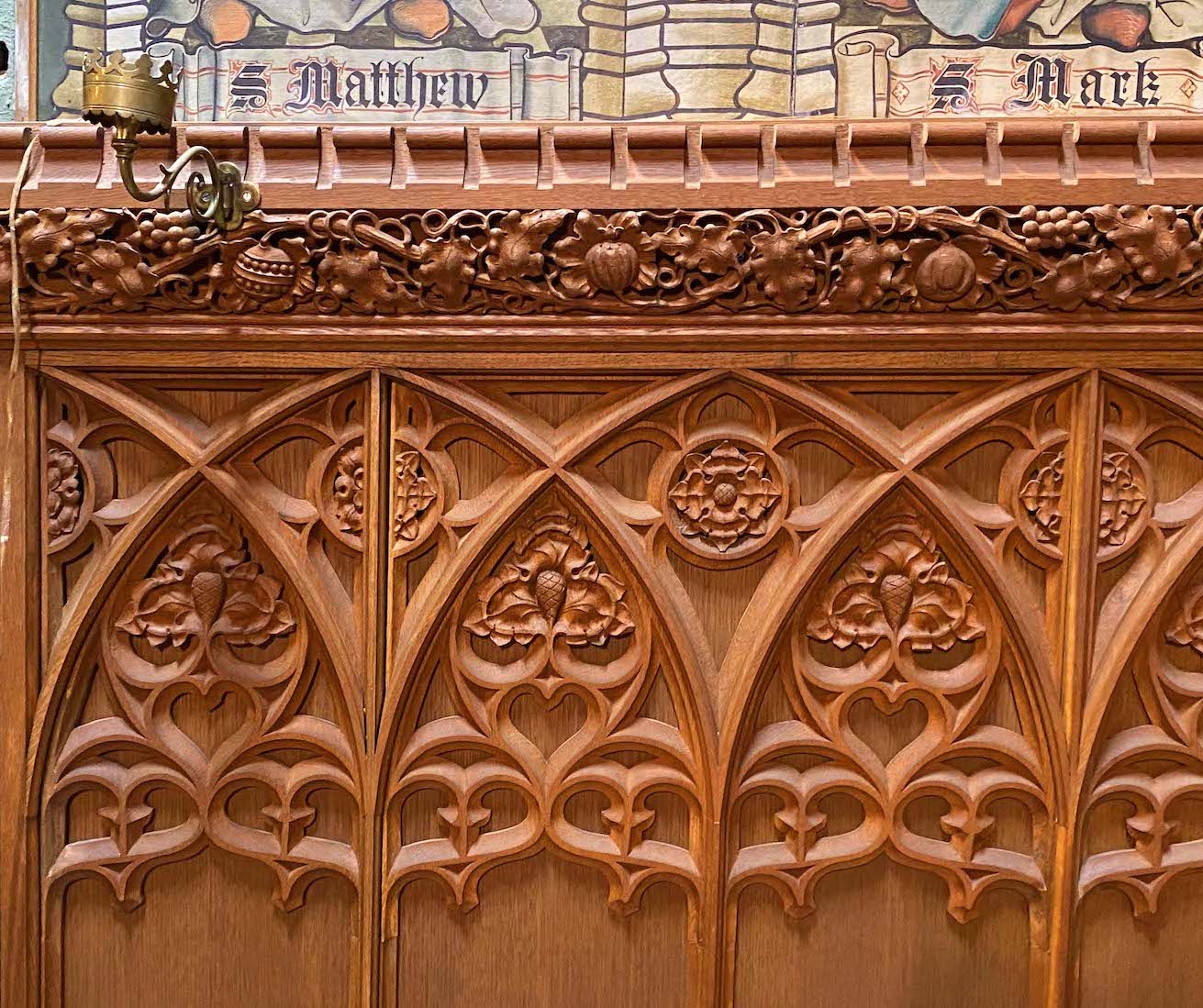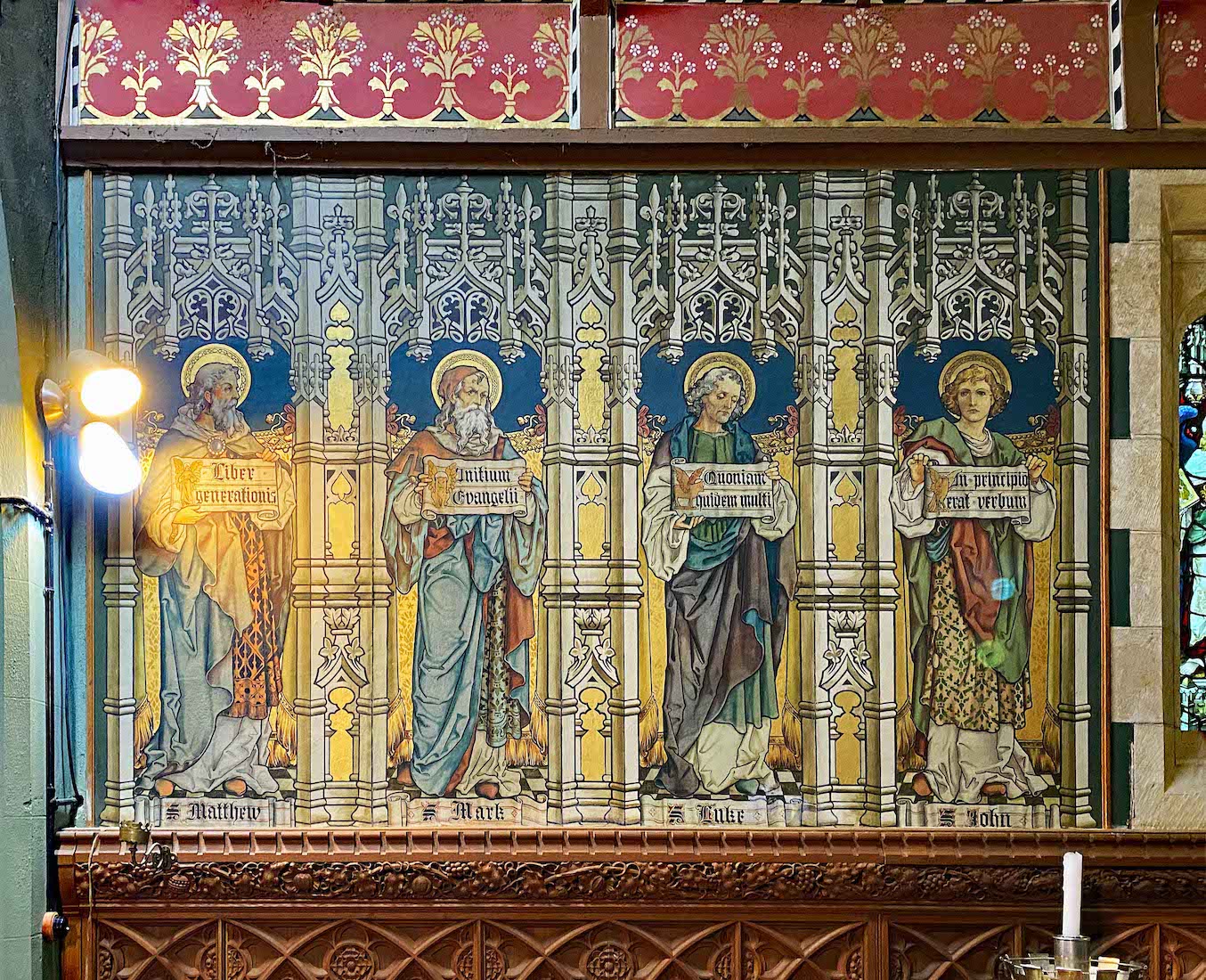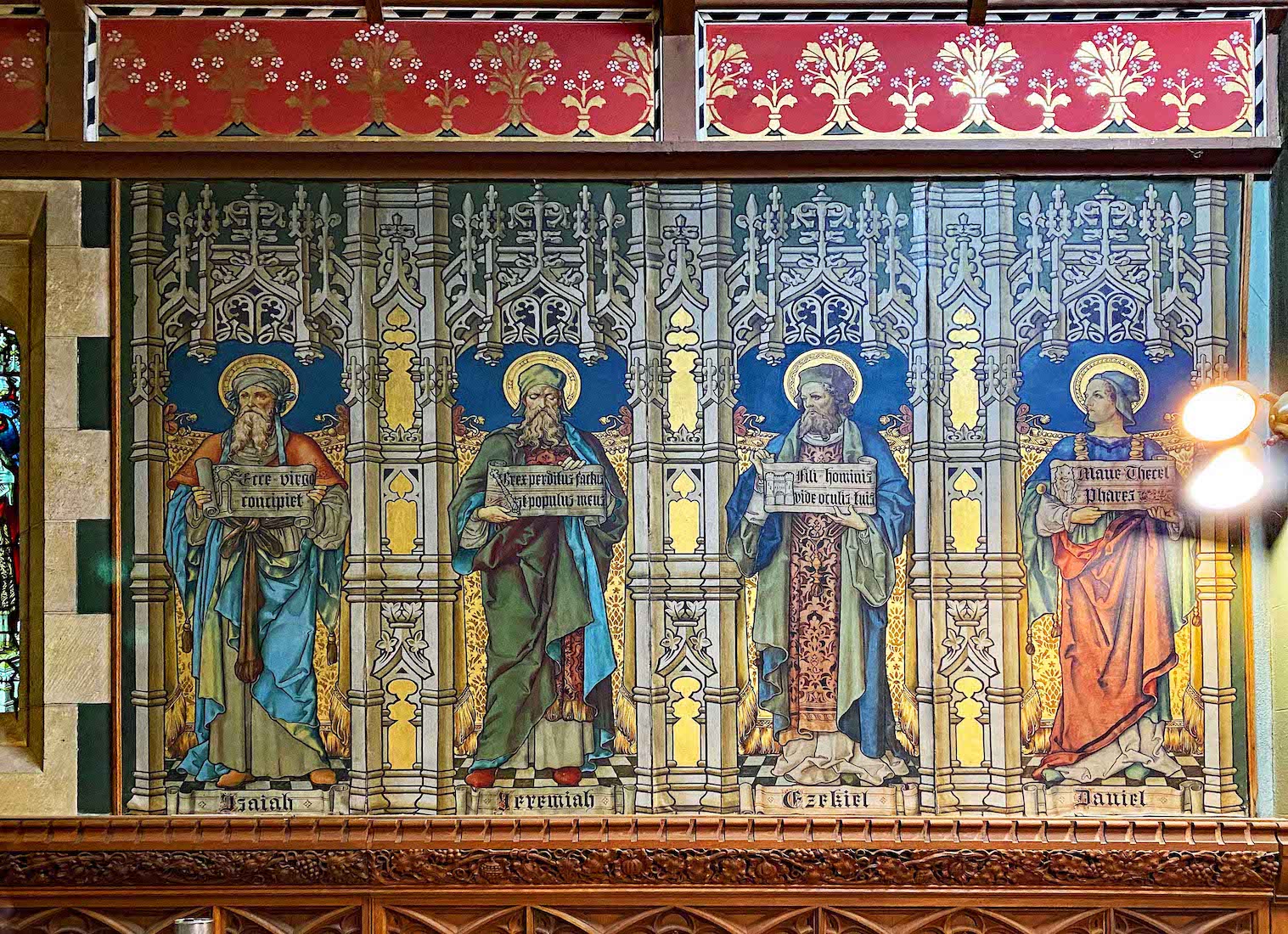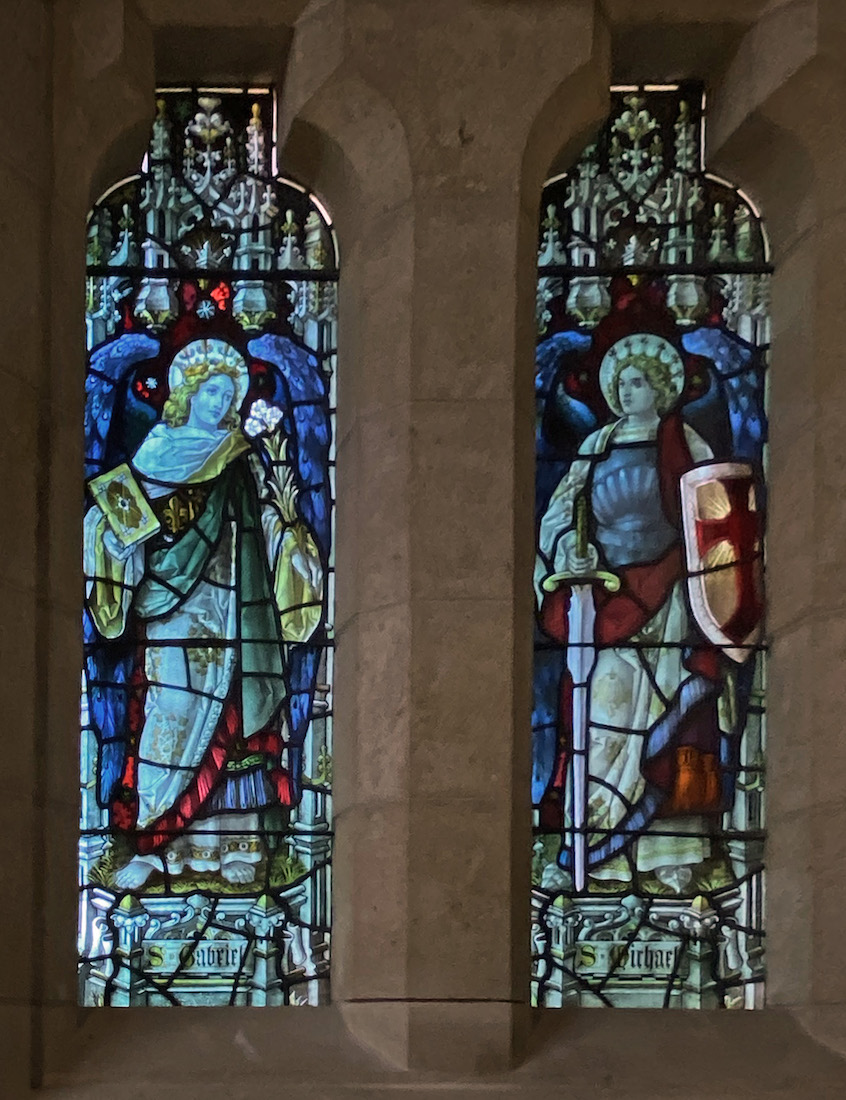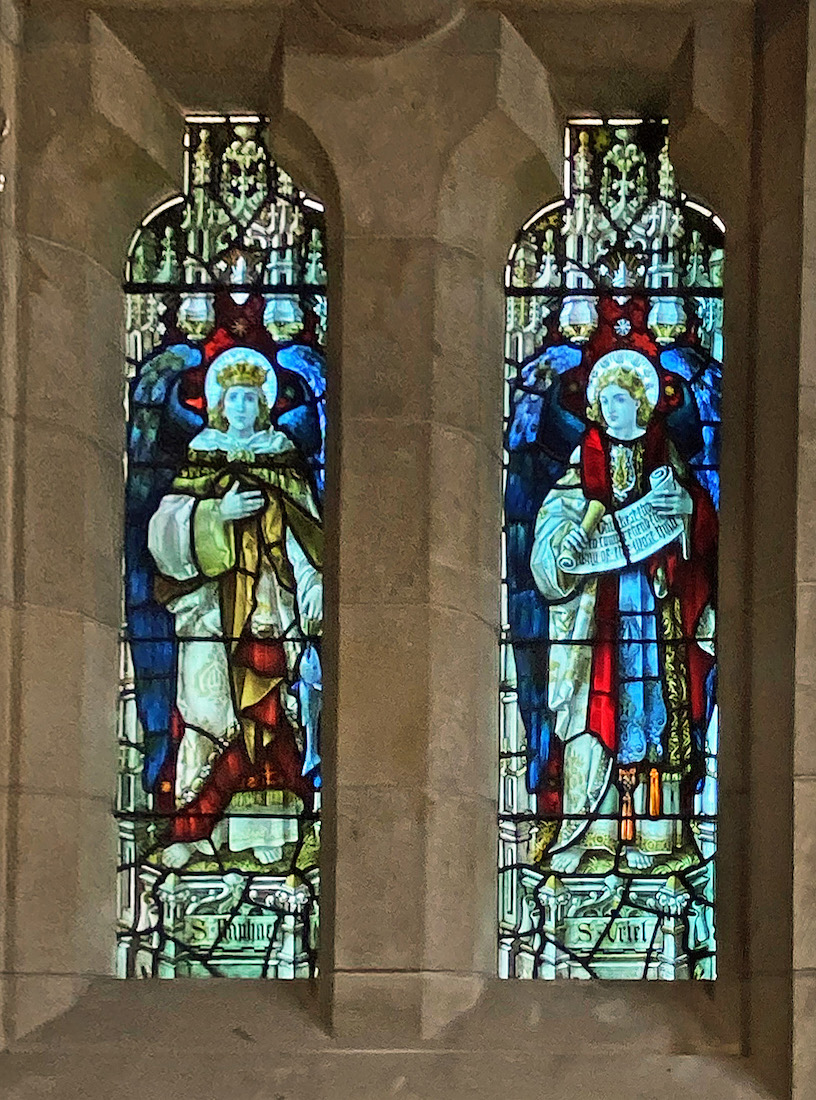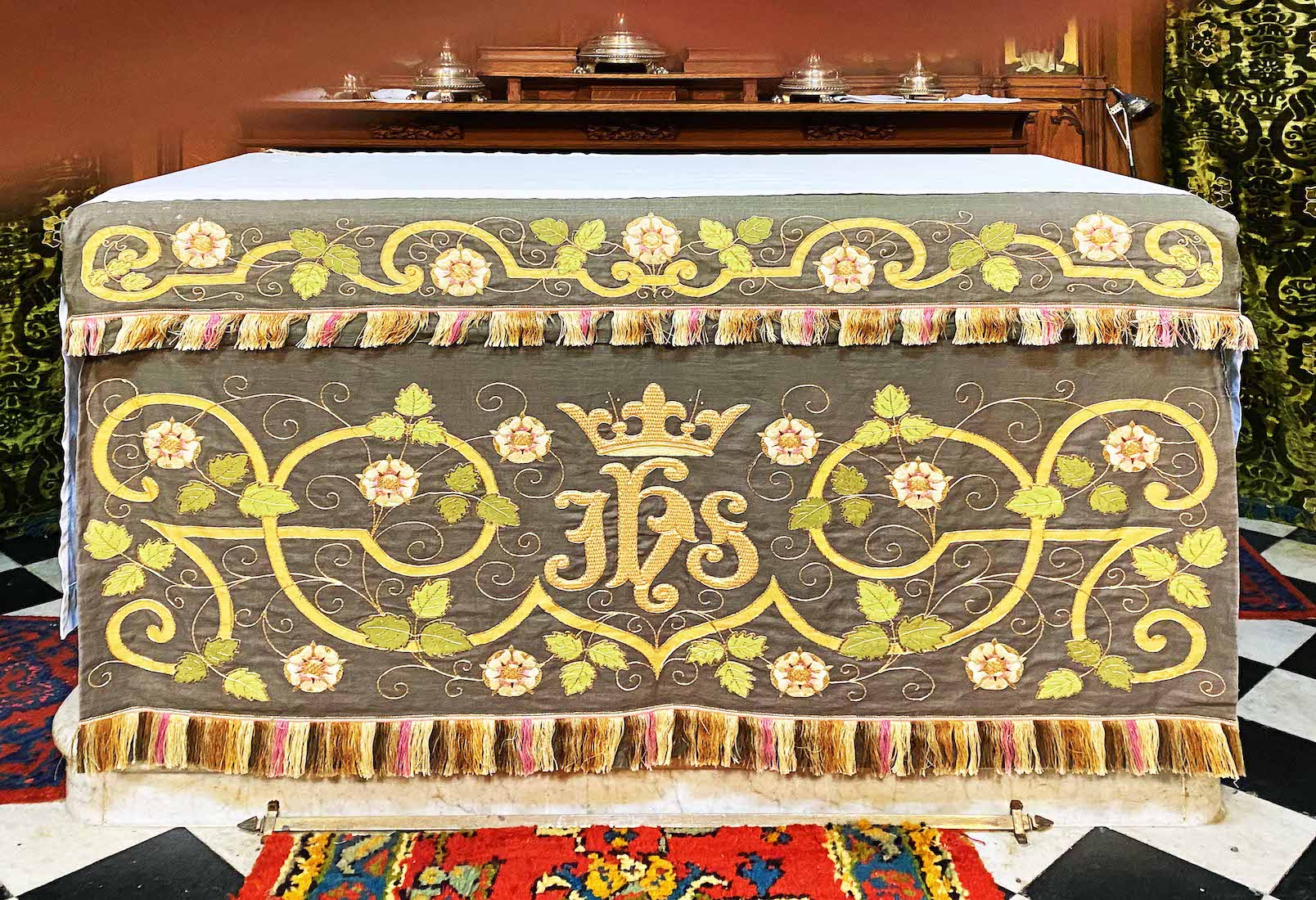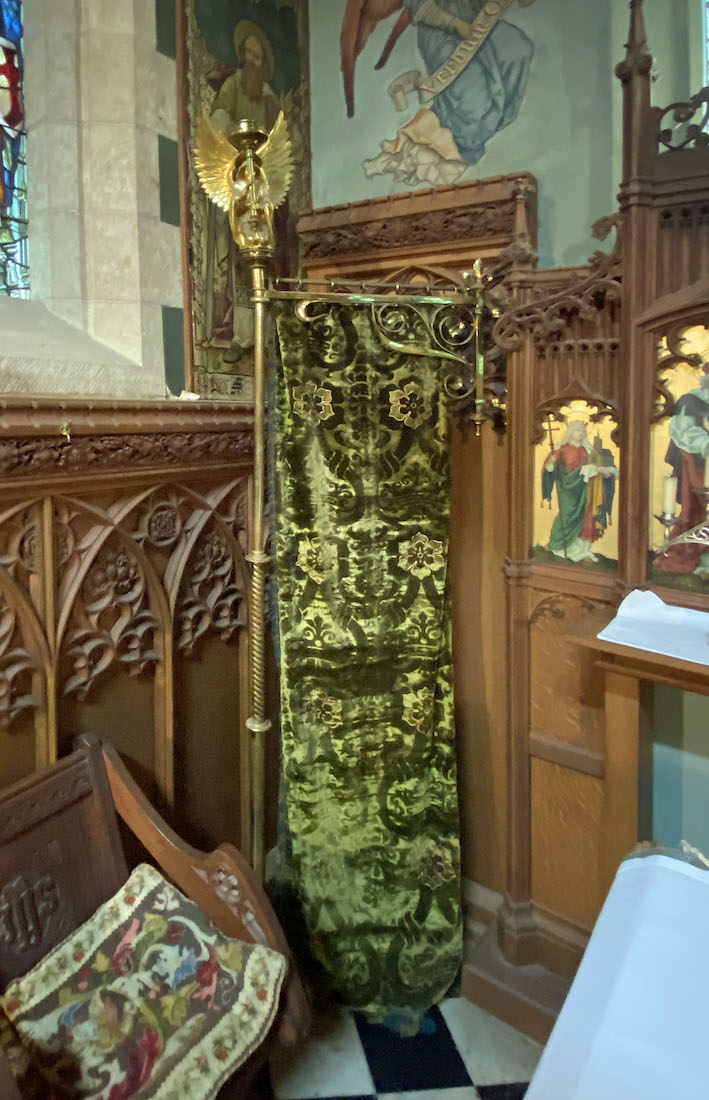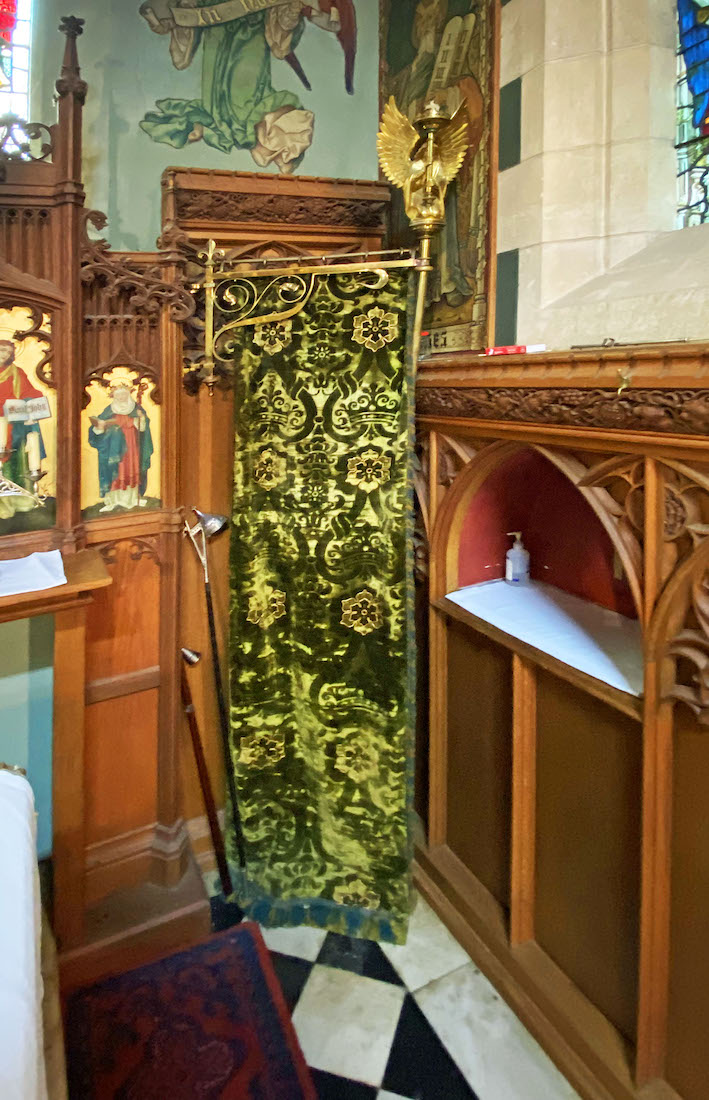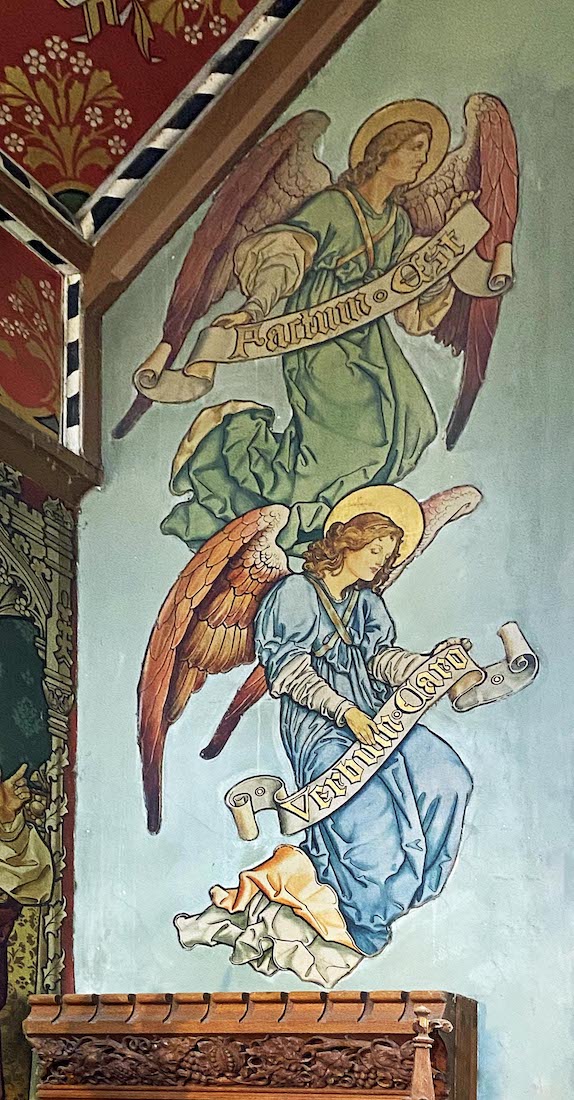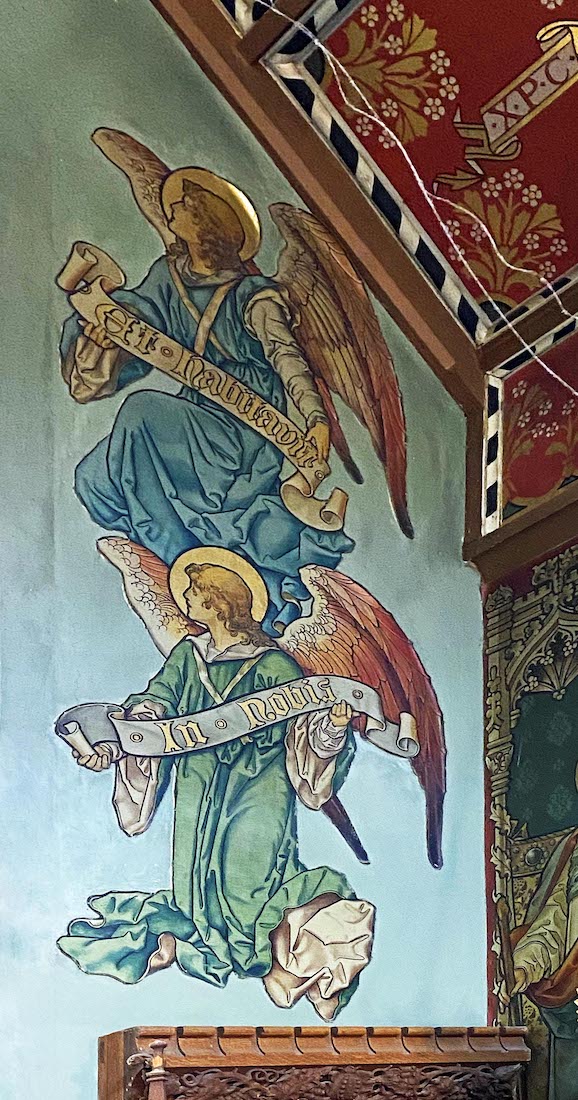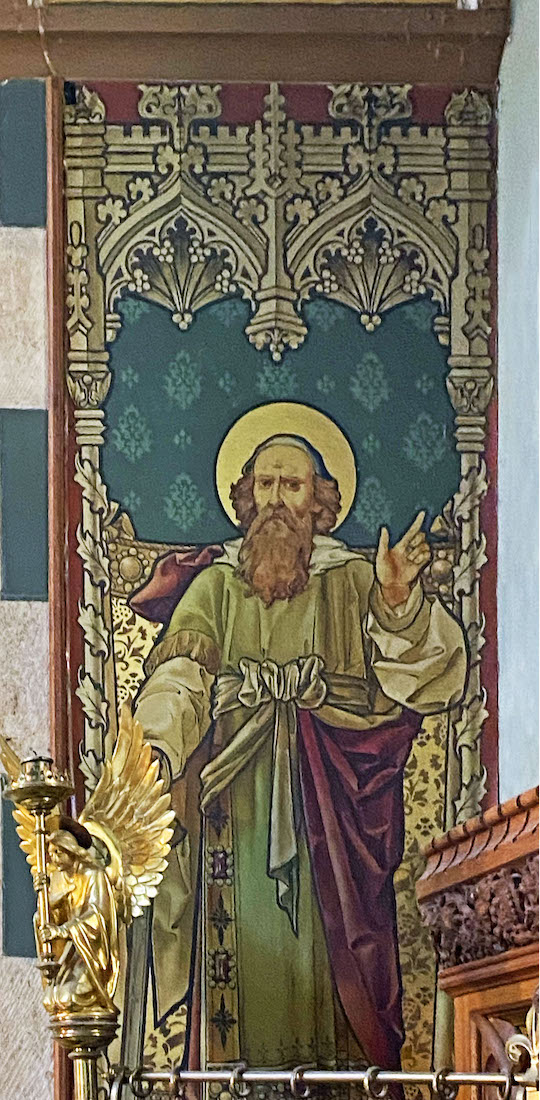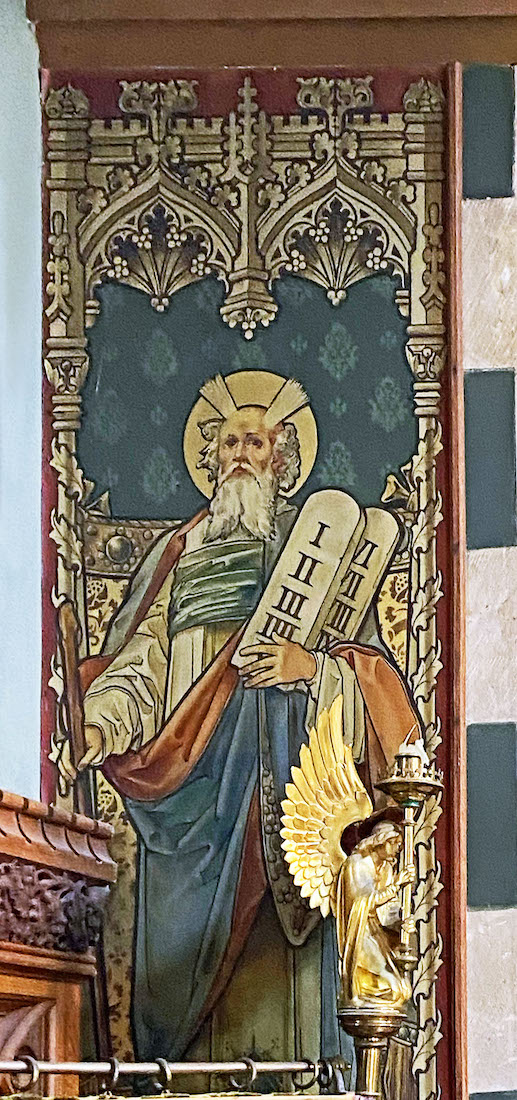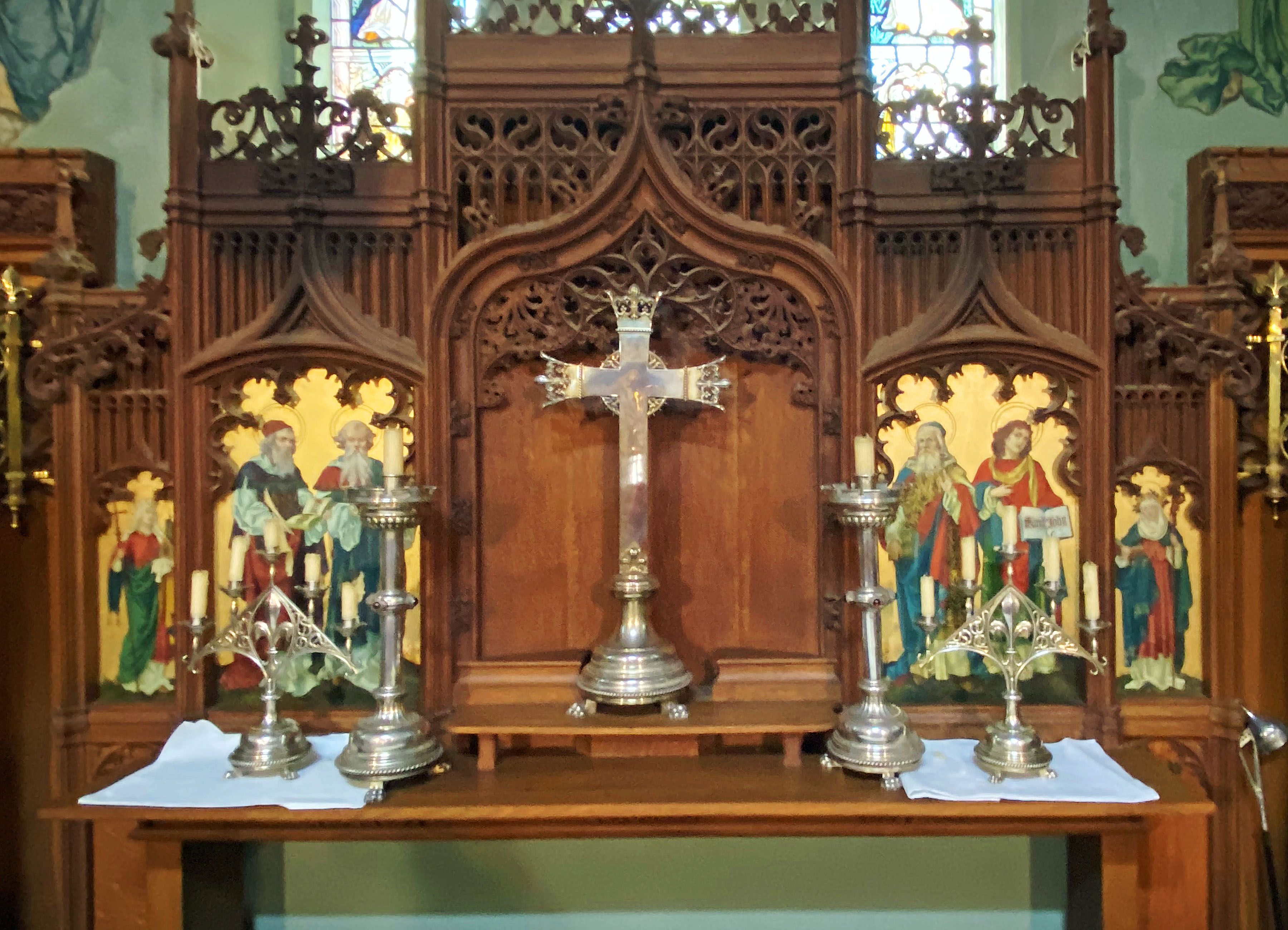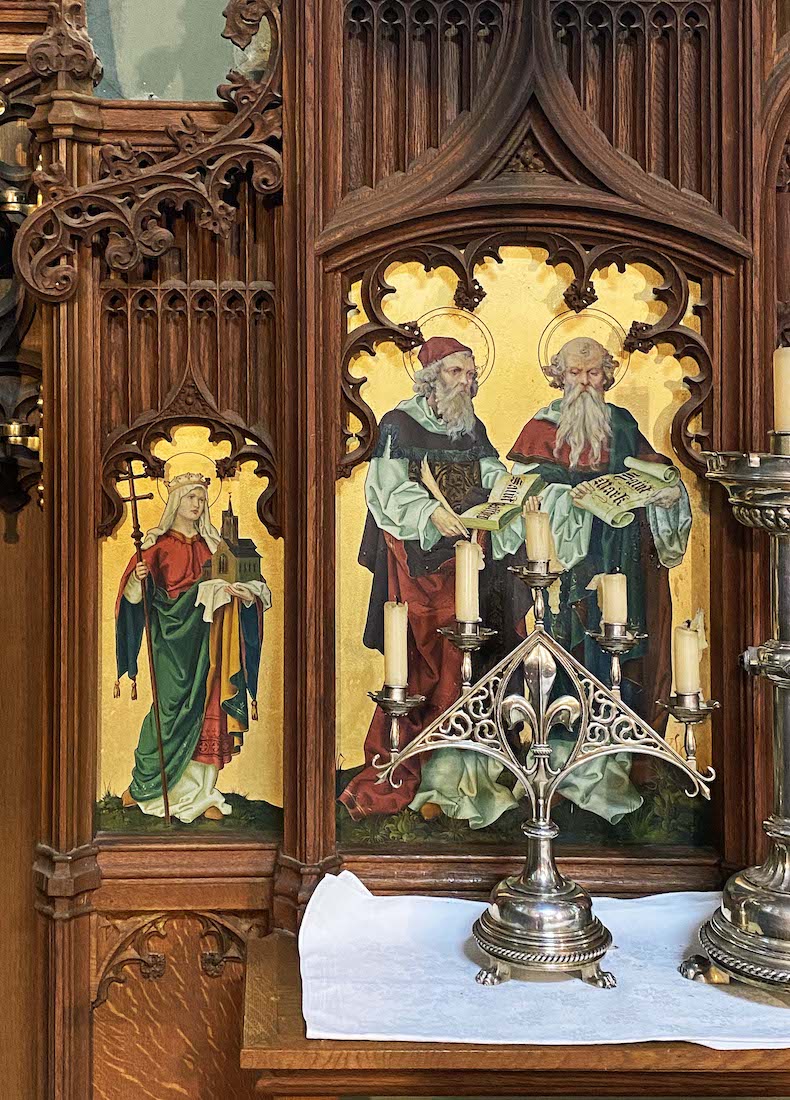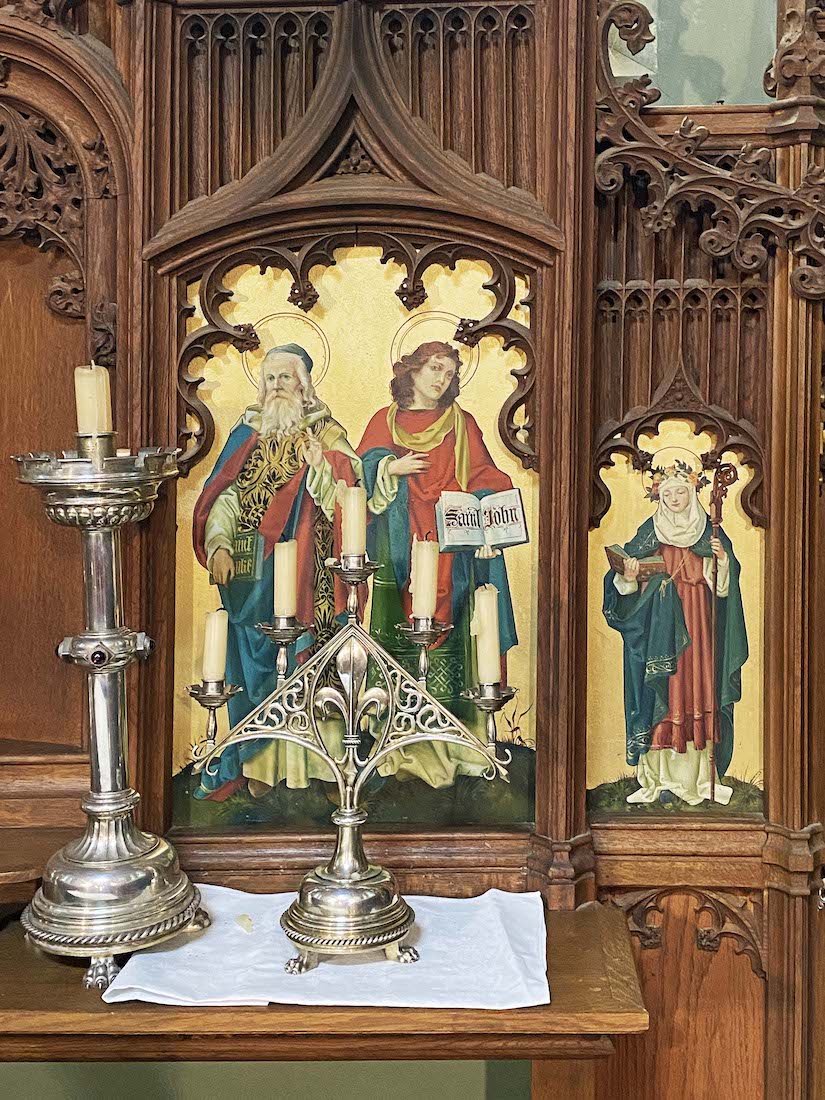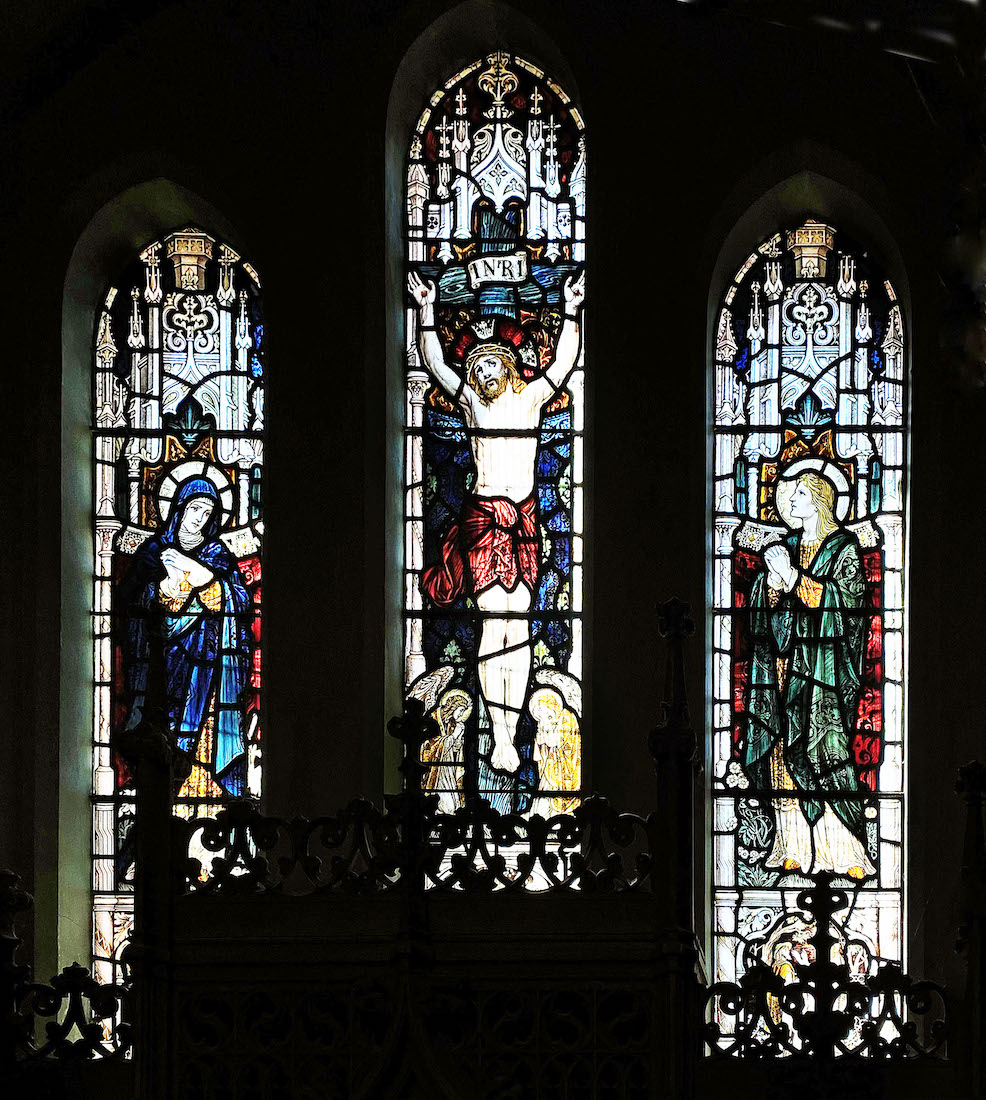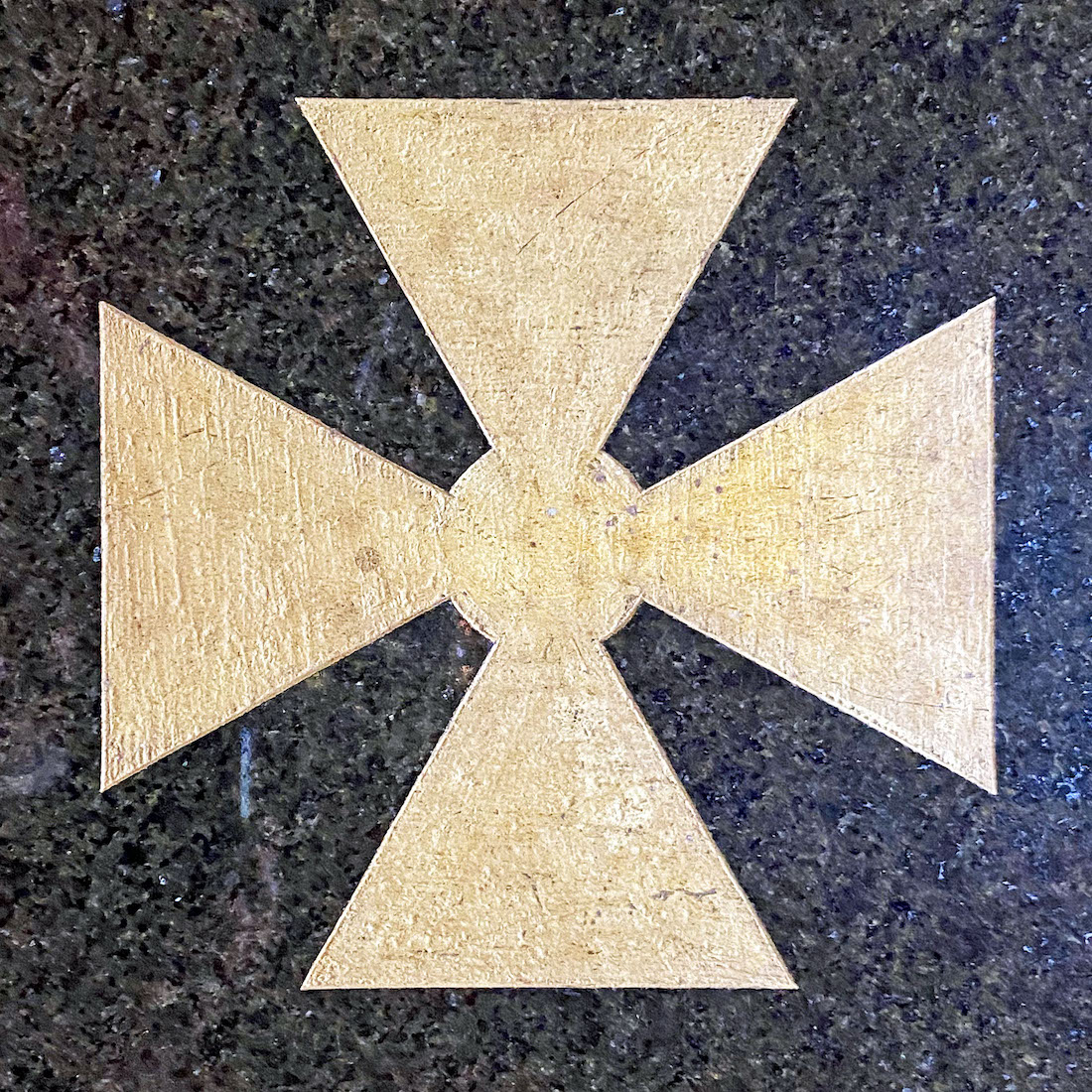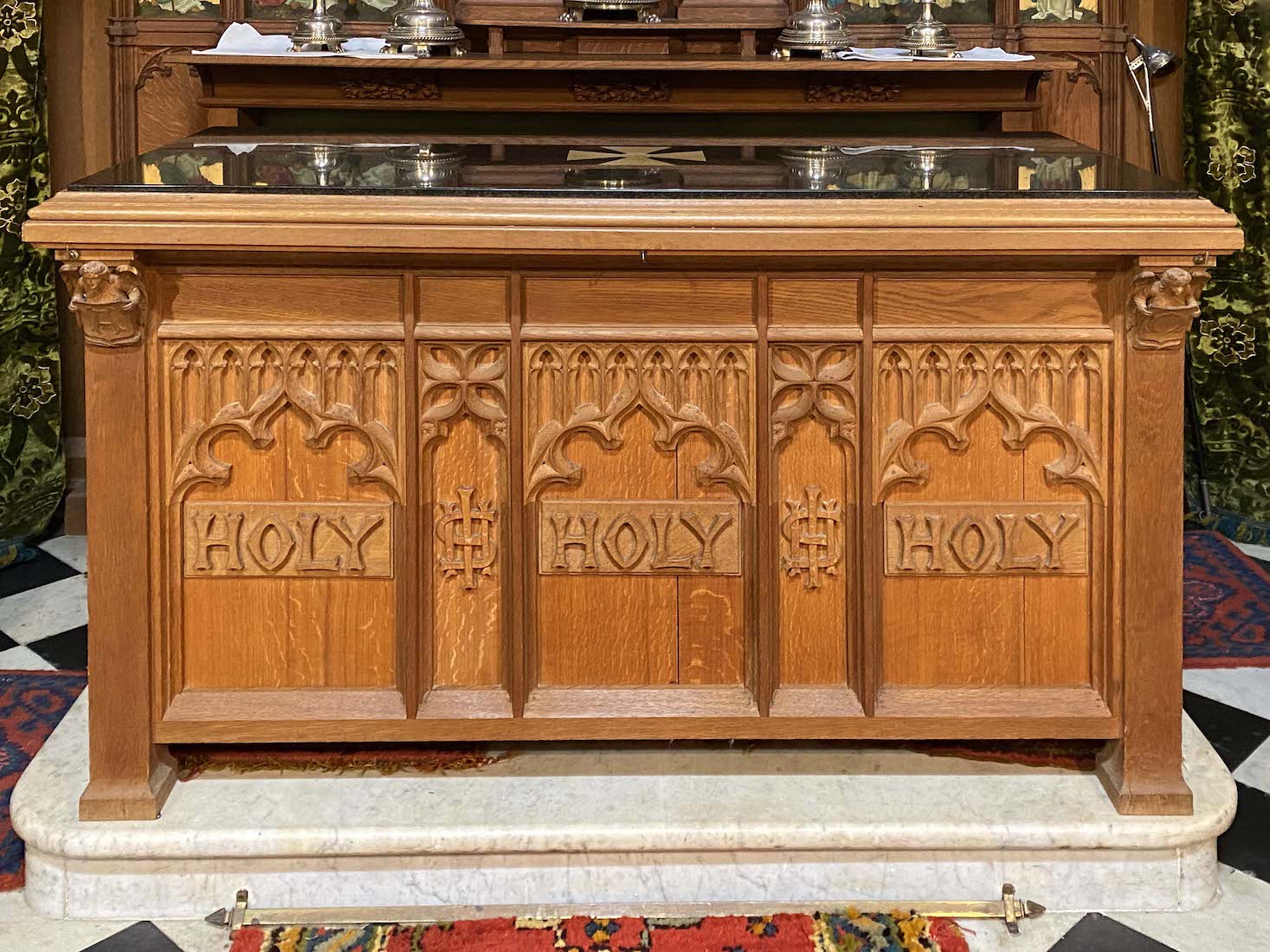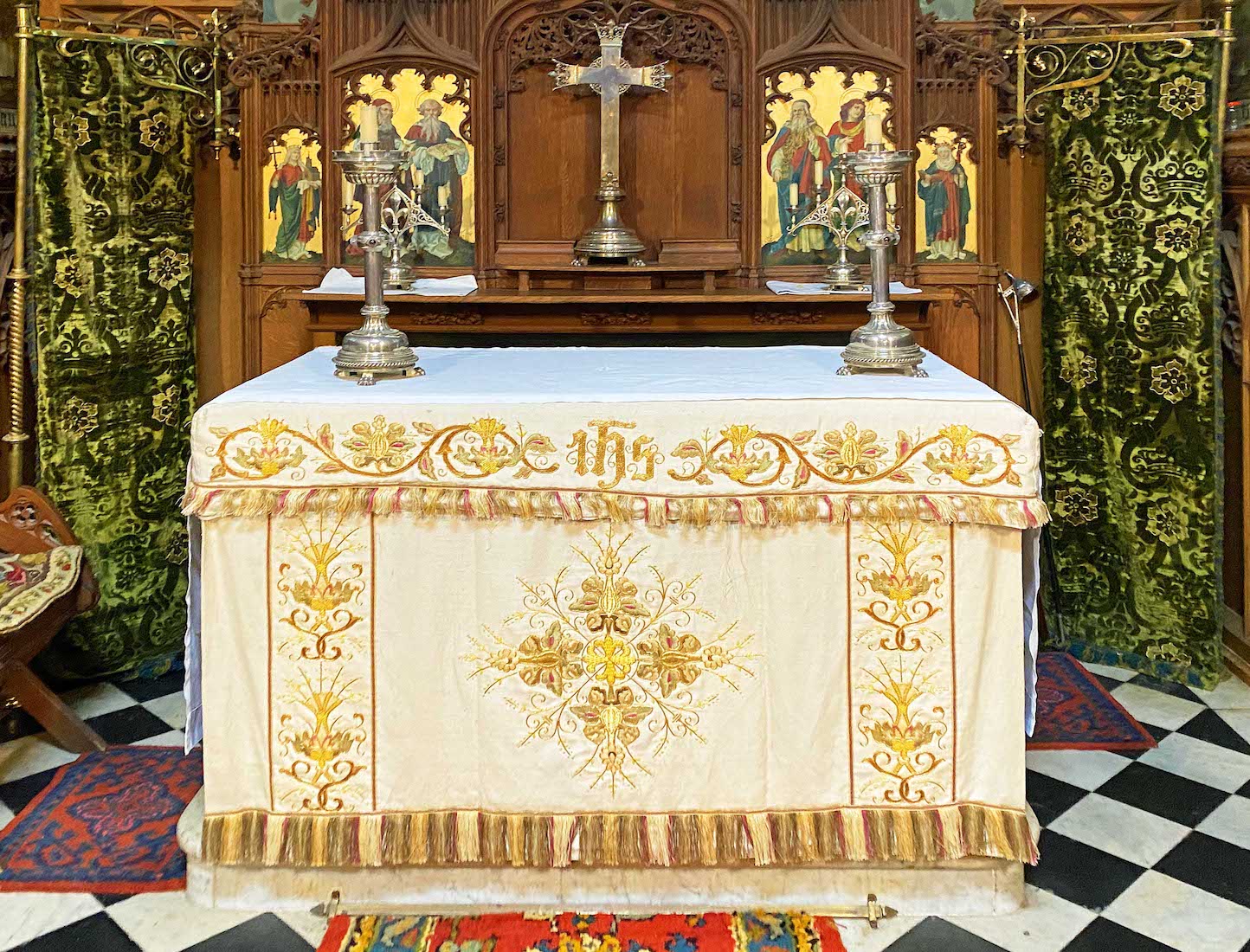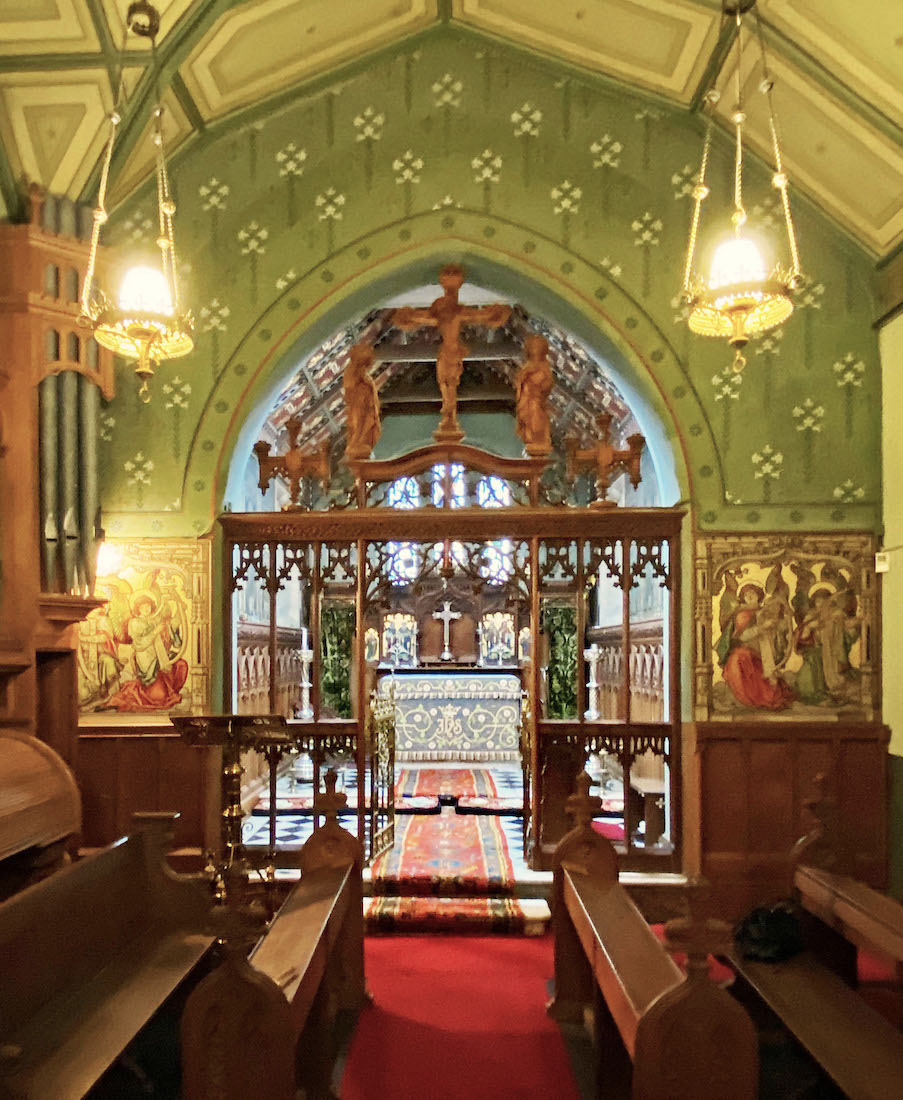
We approach the arch leading to the chancel and sanctuary, reminding ourselves that this is just a little country church! There is a dark strip evident across the middle of the flower-stencilled green panel of the arch. We realize now that this is where the old text used to be. INDEX
42. MUSICAL ANGELS
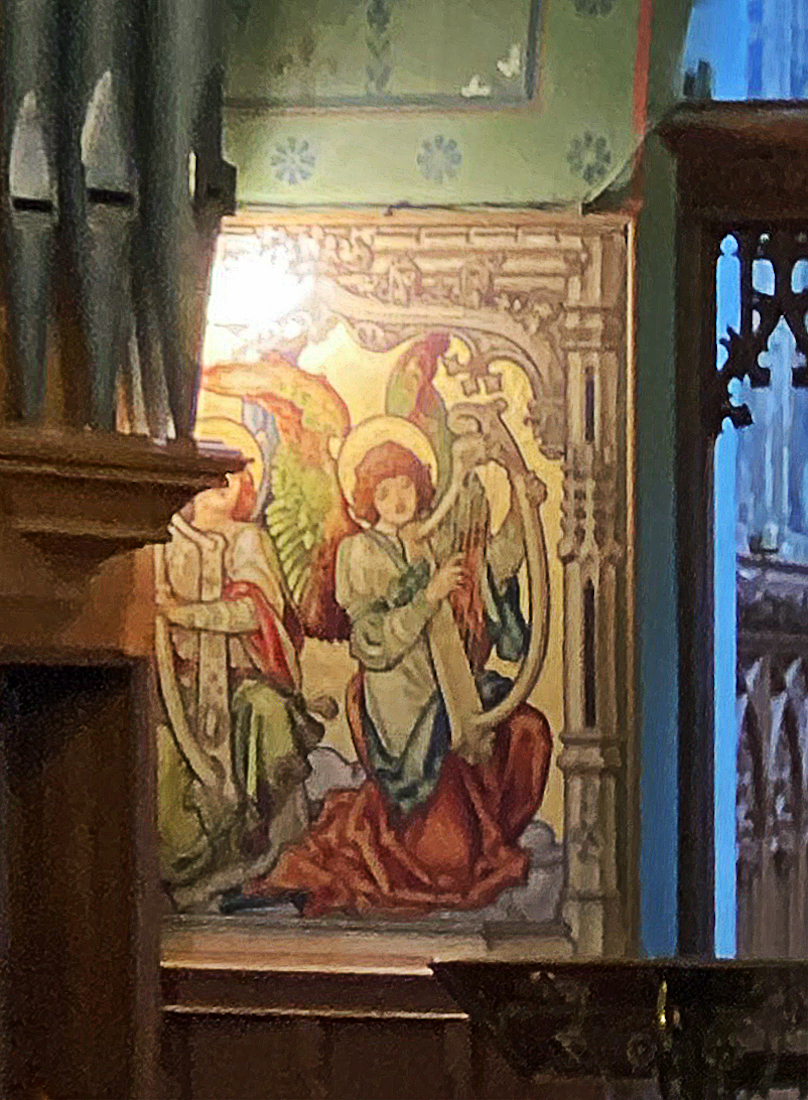
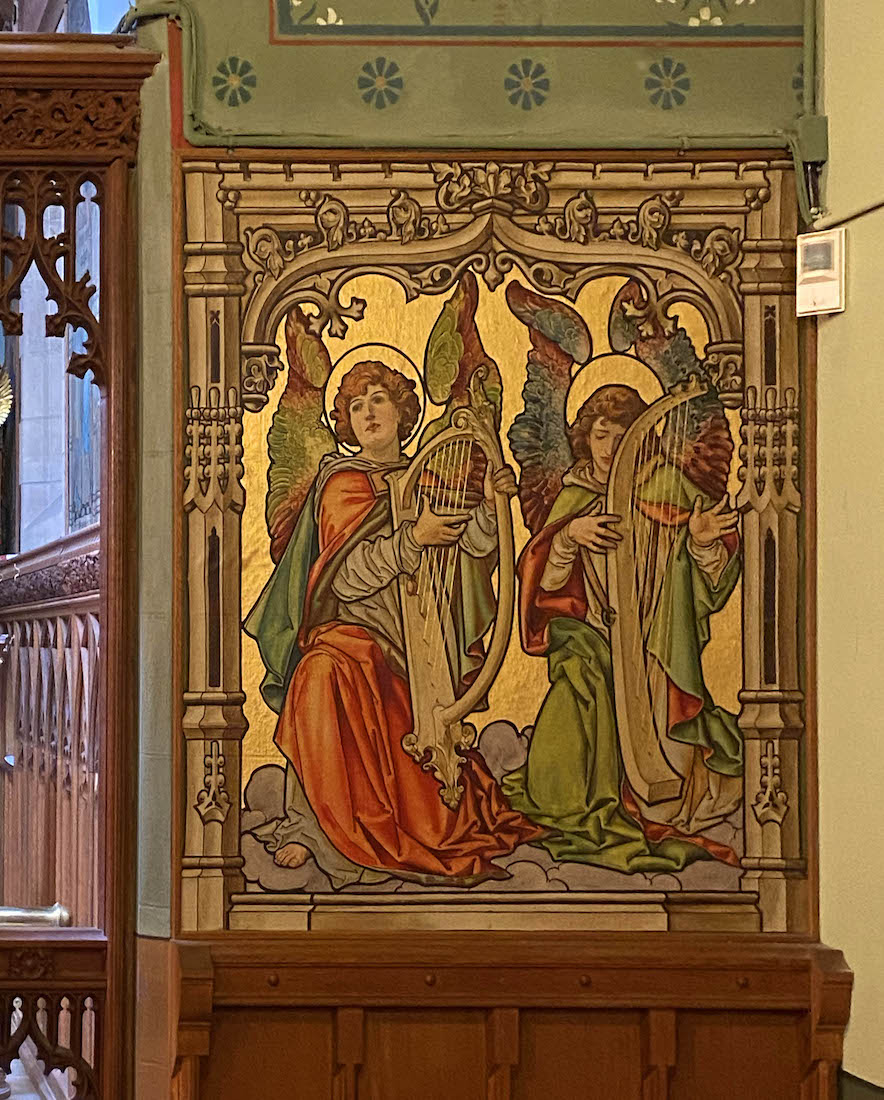
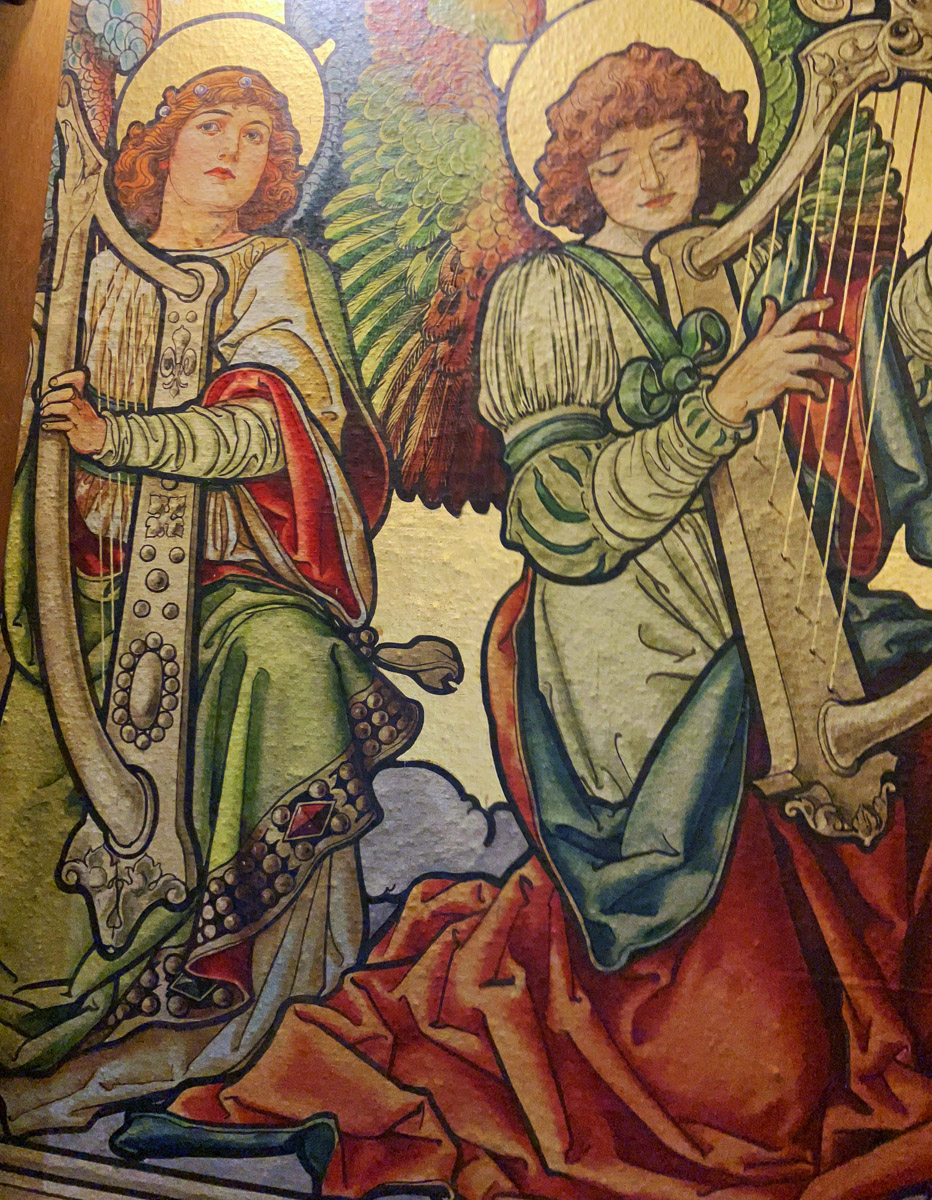
There are paintings of harp-playing angels on either side. The paintings are done on canvas and then affixed to the walls. The organ side painting is difficult to photograph because of the organ. I am grateful to Leonie Matheson for providing the fine detail in the third photograph above.
43. ROOD CROSS
There is a finely carved rood cross at the top of the chancel arch. As usual, it shows the crucified Christ with Jesus’ mother Mary below at left, and St John the Evangelist at right. I have often wondered why Christ on the Cross is usually depicted looking to his right. Perhaps it arises from the rood cross depiction where it would be natural for Christ to be looking down to his mother. To the sides are matching little pedestals, each bearing a shield with the letters ‘ihs’ – the first three letters of the name ‘Jesus’ in Greek.
44. SANCTUARY GATES
The entry to the chancel / sanctuary can be barred by two gilded metal gates. Very smart – as expected! We shall explore inside now, but notice through the bars a glimpse of a prayer desk at right, and a horizontal strip of kneelers on the floor, separating the chancel from the more distant sanctuary.
46. SANCTUARY ROOF
Above us is the chancel / sanctuary roof with its painted panels. There are two Christograms on these panels. One is the well-known IHS – a contraction of the Greek word 𝚰𝚮𝚺𝚶𝚼𝚺 or JESUS. The other is the lesser-known XPC which comes from the Greek 𝚾𝚸𝚺 . This is more tricky. XP is a transliteration of the Greek Chi-Rho which are the first two letters of Christ, and often placed together as a symbol. The Coptic word for Christ is XPICTOC, from which XPC is a natural abbreviation. If here we read the ‘C’ as an S (or a 𝚺), we get the pronunciation ‘Christos’.
47. KNEELERS
These two kneelers lie on the lower chancel floor in front of the altar rail. Various Christian symbols are portrayed here. They are: • the white lily (Easter lily, Madonna Lily) – symbol of the Virgin Mary, purity; • the pelican, drawing blood from her breast to feed her chicks – comes from an old legend, used to represent the sacrifice and shed blood of Christ; • the Agnus Dei (Lamb of God) – represents Jesus as a lamb carrying a halo and holding a banner with cross symbolizing victory; • descending dove, representing the Holy Spirit, symbol for peace and reconciliation.
48. PRAYER DESK AND RAILING
Two unrelated items in the chancel area: a nicely carved prayer desk, and one of the altar raiings.
49. SANCTUARY CANDLE AND PANELLING
At left is shown one of the sanctuary candlesticks – sterling silver from Mappin and Webb in London, and originally gilded. At right we see a section of the wall panelling, beautifully carved. Just above is a wall painting which we look at next.
50. FOUR EVANGELISTS
On the North wall of the chancel is a painting of the Four Evangelists: St Matthew, St Mark, St Luke and St John. Each Evangelist holds a scroll bearing his traditional symbol, and the first words of his Gospel. So we have from left: •• Matthew – angel, ‘The book of the generations’; •• Mark – winged lion, ‘The unity of the gospel’; •• Luke – winged bull, ‘Since indeed many’; •• John – eagle, In the beginning was the Word’. As before, the painting is done on canvas and affixed to the wall.
51. FOUR PROPHETS
On the South wall of the chancel is a painting of four prophets: Isaiah, Jeremiah,Ezekiel and Daniel. Again each prophet holds a scroll with a symbol and some text from his book. Again from left: •• Isaiah – unknown symbol?, ‘Behold the virgin shall conceive’ (7:14); •• Jeremiah – rod? , My people have become lost (50:6); •• Ezekiel – city wall, ‘Son of man, look with your eyes’ (40:4); •• Daniel – lion symbol, ‘Mene Mene Tekel Upharsin’ (5:25 – the writing on the wall at Belshazzar’s feast).
52. SANCTUARY ARCHANGELS
There are double-light windows on the side walls of the sanctuary –the North side at left above, and the South side. These windows depict the four archangels: Gabriel, Michael, Raphael and Uriel. These windows were probably made by Powell’s of London. These are the four archangels most depicted in art: Gabriel, the messenger of God who brought the announcement of Christ’s birth to the Virgin Mary; Michael, the dispenser of justice; Raphael, the healer and protector of travellers; and Uriel, the angel of prophecy and wisdom.
53. ALTAR
When we arrived at St Matthew’s the altar was adorned with this beautiful frontal with the crowned symbol ‘IHS’ we discussed previously, and a luxuriant vine. The attached white flowers appear to be the Yorkshire rose representing innocence and purity.
54. SANCTUARY CORNER SCREENS
There is a beautiful green velvet screen in each front corner of the sanctuary. These screens were a feature in English churches before the reformation, but were removed because of the perception that ‘unho;y practices’ might be occurring behind them. It has been jokingly suggested that they should stand facing the altar now to prevent this!
55. EAST WALL ANGELS
Two pairs of facing angels are painted on the East wall. They carry small scrolls with the text (in Latin): ‘The Word was given and he dwelt amongst us’ (John 1:14).
56. ST PAUL AND MOSES
On the side walls of the sanctuary, closest to the Eastern corners, and partially hidden by the green velvet screens are two large painted figures. On the North side, St Paul, and on the South side, Moses carrying the tablets of the Law. Interestingly, Moses is pictured with ‘horns‘ coming out of his head. Old manuscripts tell us that Moses came down from Mount Sinai with his face radiant. One early translation interpreted this as ‘with horns’ – not a widely accepted translation these days. ••• Notice in these photos the two golden angels carrying their candlesticks.
57. REREDOS
Behind the altar is a small table, and also a wide screen known as a reredos. This reredos is constructed in the form of a carved triptych with a central cross, and painted panels on either side.
58. SILVER AND REREDOS DETAIL
On display here are a couple of silver candlesticks, two silver five branch menorah, and a central silver cross. This particular menorah is for those in their years of mourning of a deceased loved one, so appropriate for a memorial church. My attention is drawn to the central Cross with its crowned ends. In fact the cross does not have nay painted embellishment! The side panels of the reredos behind depict the Four Evangelists. At the ends are pictured St Helena and St Ethelreda, said to be chosen by Henry Dutton in memory of his wife Helen and daughter Ethel.
59. EAST WINDOW
The East window of the sanctuary shows a crucifixion scene with Christ on the Cross, and the Virgin Mary and St John the Evangelist below. The Cross has the letters ‘INRI’ at the crossing, standing for ‘Jesus of Nazareth, King of the Jews’. The base of the window is hidden by the top of the reredos.
60. ALTAR AND ALTAR CROSS
When the altar is uncovered, looking down we can see the top black marble slab (mensa) with its incised gilded silver cross. The cross is a version of the pattée cross, known as the St George’s Cross in Sweden and the Cossack Cross in Ukraine. The front of the altar has the text Holy, Holy, Holy embossed on it alternating with the familiar IHS symbol. Notice the angels holding the symbols ‘Alpha’ and ‘Omega’. As we left, the altar was adorned with its new cream and gold frontal – a thing of beauty.
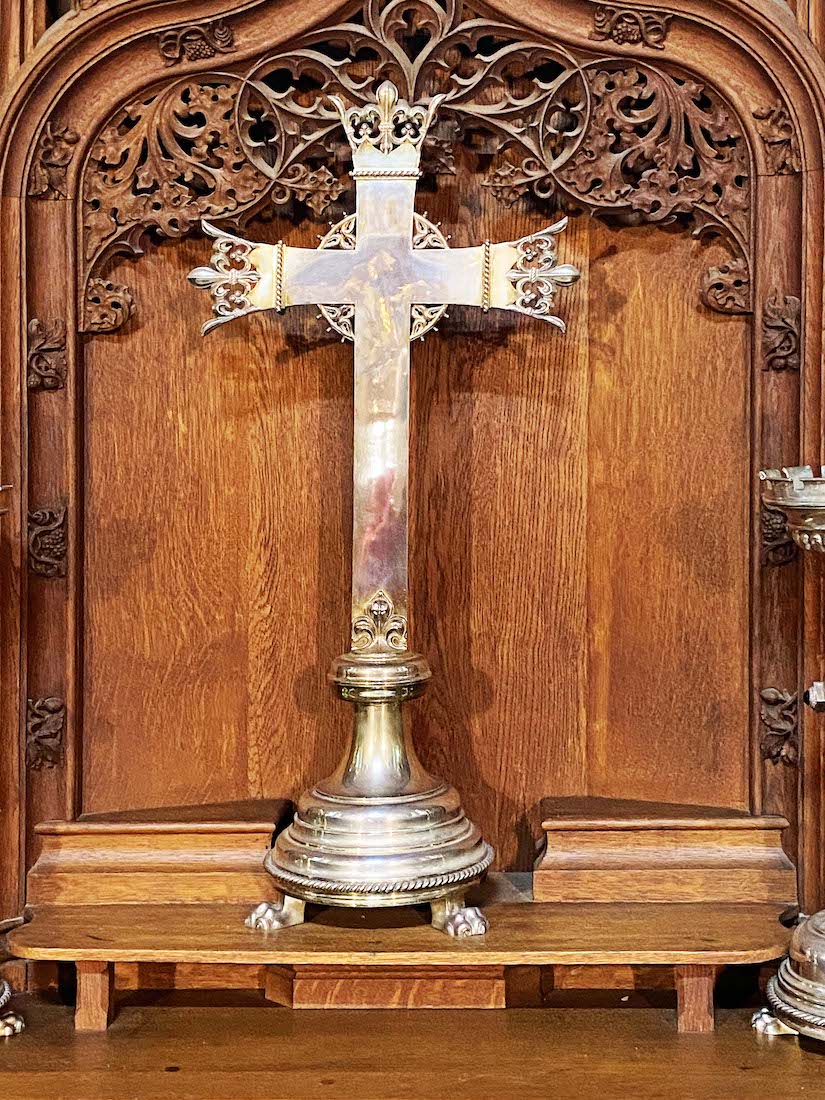
CONCLUSION
Well, isn’t St Matthew’s a surprising and amazing church – a pleasure to visit and photograph! I hope you have enjoyed visiting it as much as I did.
I am happy to receive constructive comments or corrections concerning this website. The best websites are the ones which have no errors! I am grateful to my wife Margie who came to Hamilton with me, and who has proof-read these pages.
Also, my sincere thanks to Mary Anne who gave her valuable time to give us access to the Church, and who let me have a copy of her ‘tour notes’. These have been invaluable in assembling the text for this site.
St Matthew’s Anglican Church does not have its own website. However an online search for ‘St Matthew’s Church Hamilton’ will bring up a number of different informative sites.
Site created 11 / 2023
Paul Scott

